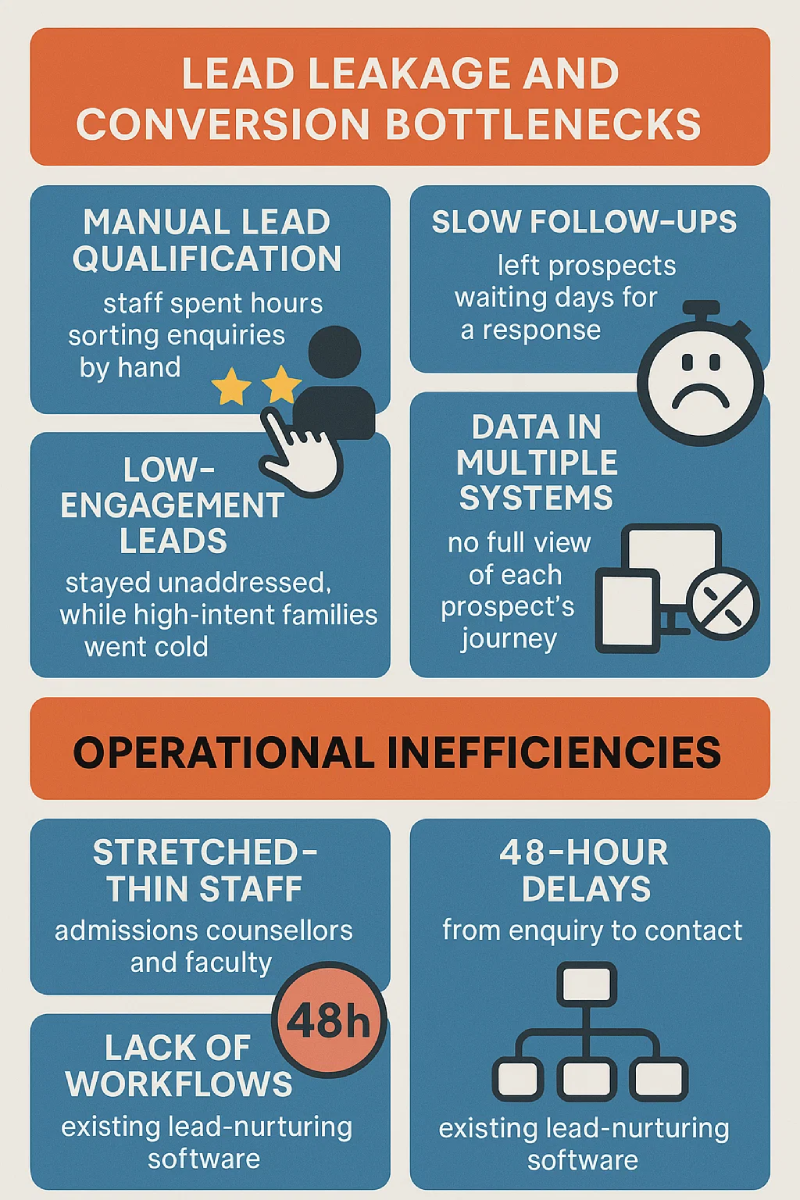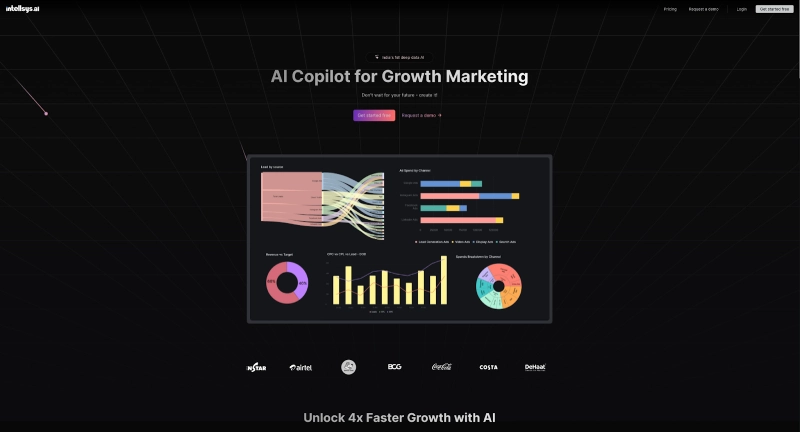How Cambridge Tripled Lead‑to‑Admission Conversions (3.2x) Using Behavioural Lead Scoring

At Cambridge School, leads were slipping. With institutions growing, education lead generation has never mattered more. The administrators realised the reason: Manual follow-ups took too long, and many enquiries got lost in back-and-forth communication. The school wanted a faster, more reliable way to turn interest into enrolment.
Their solution was behavioural lead scoring: grade each prospect by how they behaved (website visits, form fills, or event RSVPs) and chase the hottest leads first.
Cambridge School scored enquiries in real time and fed results straight into its admissions CRM by teaming up with OttoScholar. That cut delays, focused staff effort where it mattered most, and set the stage for a 3.2x jump in lead-to-admission conversions.
This edtech case study breaks down how the Cambridge School used OttoScholar’s tools and integrations to make it all possible. We’ll begin with the challenges they faced, then move to the features that mitigated them, and the best practices that helped most during this phase.
Understanding behavioural lead scoring
Every lead, be it within any given industry, has different potential. If a lead is only interested in enquiring, following up with them only wastes resources and time.
On the other hand, if a lead is ready to convert but they don’t receive the right attention, they slip through the fingers.
Behavioural lead scoring solves this problem by matching each lead with a sales funnel for maximum growth. As part of an admissions CRM-powered funnel, it assigns points to prospects based on what they do, like visiting web pages, opening emails, or signing up for events, so you know which leads are worth following up on.
Difference between demographic vs behavioural scoring
According to research, institutions with a developed funnel saw a 40% higher admissions conversion rate than those with none in place. For institutions, lead scoring models lean more towards two specific ones: demographic and behavioural.
By combining lead scoring software with clean data, schools jump-start better funnel visibility. While demographic scoring provides basic profile fits, behavioural scoring delivers more timely and accurate prioritisation, and is generally more effective at driving conversions.
Here’s a clear comparison of demographic vs behavioural lead scoring across five key aspects, which explain why Cambridge School chose the latter:
Every click, download, or form fill becomes a data signal. 68% of top marketers report that scoring based on content engagement drives the biggest revenue impact. By tracking these signals, Cambridge School focused on leads most likely to enrol.
Cambridge’s challenges before implementing behavioural lead scoring
Before OttoScholar and behavioural lead scoring, Cambridge School faced two big pain points:
1. Lead leakage and conversion bottlenecks
-
Manual lead qualification meant staff spent hours sorting enquiries by hand, and many were lost due to issues that could have been controlled.
-
Slow follow-ups left prospects waiting days for a response, increasing the drop-off rates.
-
Data sat in chunks across multiple systems, so no one had a full view of each prospect’s journey.
-
Without clear signals, low-engagement leads stayed unaddressed, while high-intent families went cold.
-
Cambridge School needed a modern education CRM software suite to unify records.
2. Operational inefficiencies
-
Admissions counsellors and faculty were stretched thin by repetitive manual tasks.
-
Delays from enquiry to contact crossed 48 hours, causing lost opportunities and frustrated parents.
-
Existing lead-nurturing software was rigid, lacking the workflows needed to re-engage hesitant families.
See how Cambridge tackled faculty efficiency with 100+ saved hours in detail

These gaps in process and technology created friction at every step. From initial contact to signed offer, there was no clear funnel setting the stage for a smarter, data-driven solution.
Cambridge School x GrowthJockey: Implementing behavioural lead scoring
After laying the groundwork, Cambridge School partnered up with Growthjockey to use OttoScholar, an education lead generation software. They moved swiftly through four key steps to bring behavioural lead scoring live.
Step 1-Platform selection: OttoScholar and intellsys
Cambridge chose OttoScholar for its behavioural scoring engine that plugs into any higher education CRM, adding intuitive lead-nurturing software and workflows for business growth, and a unified dashboard. They paired it with Intellsys.ai for advanced AI-driven intent analysis.
Both tools were smoothly integrated into the school’s existing admissions CRM and data warehouse.
Step 2-Picking the right OttoScholar features
Real-time behavioural scoring: Instantly logs every web visit, form submission, event RSVP, and email click so Cambridge School could spot and act on hot leads within minutes.
Customisable score weightings and thresholds: Let users drag and drop to set exactly how much each action is worth and adjust cut-offs, matching the scoring model to recruitment goals.
Automated lead segmentation: Automatically groups enquiries into dynamic lists (hot, nurture, or re-engage), based on scores, removing manual list-building.
Central dashboard: Provides a single view of lead health, pipeline speed, and forecasted admissions, so managers can see at a glance where to focus next.
Step 3 Intellsys integration and algorithm calibration
Cambridge School fed its past admissions records and fresh engagement signals (page visits, form fills, event RSVPs) into Intellsys's predictive lead scoring toolkit.

The team then trained the scoring model on historical cohorts, tried out different score cut-offs, and kept fine-tuning it using real enrolment outcomes. This way, the system learns and improves with every new application.
Step 4-Workflow automation and personalised outreach
Finally, OttoScholar triggered multi-channel campaigns via email, SMS, and in-app messages as scores changed, while Intellsys.ai sent real-time alerts for top-intent leads.
Read on how Growthjockey tackled parent communication, boosting satisfaction scores
Context-rich profiles were automatically handed to admissions counsellors, guaranteeing that no hot enquiry ever went cold. Through this automation, they were able to cut the cycle in half, going from 40 days to 18 days.
Road to tripling lead-to-admission: Nurturing high-potential leads
The school now had a map to a proper funnel, and a building a real-time scoring engine, so they knew exactly which leads to prioritise. They then focused on nurturing the highest-potential leads every step of the way, and this is how they followed through:
Parent and student engagement journeys
Recognising that both students and guardians play a role in the admissions process, Cambridge School built parallel nurture tracks: Prospective students received invites to virtual open days and deadline reminders, while parents got progress updates and assessment tips.
All interactions - webinars watched, forms submitted, reminders clicked fed back into the student enrolment CRM to keep every profile up to date and map out the next best action.
Results, impact, lessons learned, and best practices
Cambridge School’s move to an AI-driven admissions funnel paid off fast. Lead-to-admission conversions shot up 3.2x, turning lukewarm enquiries into confirmed offers at more than triple the previous rate.
Simultaneously, onboarding time increased by 82%, so families moved from application to enrolment in days rather than weeks. Meanwhile, the turnaround from first enquiry to offer improved by 65%, which kept the families engaged without frustration through a more responsive process.
Operational gains
Admissions staff regained about 100+ lost hours as manual sorting and follow-ups gave way to automated scoring and workflows.
Moreover, instant lead prioritisation meant counsellors spent their time only on top-tier enquiries, reducing back-and-forth by over half.
At a glance, dashboards delivered full visibility into lead health, challenges, and forecasted enrolments, so managers could spot and solve issues before they grew.
Lessons learned and best practices
-
Centralise your data: Clean, unified records are the backbone of accurate scoring.
-
Monitor and recalibrate: Treat your scoring model as living; run regular tests, tweak thresholds, and feed real outcomes back in.
-
Blend tech with touch: Automate routine outreach, but keep human follow-up for personal or complex queries.
-
Mind privacy and compliance: Always ensure your workflows and data policies meet local regulations, especially when handling student and family information.
Conclusion and next steps
Cambridge School’s behavioural lead scoring adaptation delivered a 3.2x boost in lead-to-admission conversions, an 82% cut in onboarding time, and clearer visibility into every prospect’s journey.
Institutions inspired by this case study should start by centralising data, defining clear score criteria, and blending automated touches with human follow-up. As AI lead-scoring tools evolve, expect even finer intent signals, real-time personalisation, and deeper CRM integrations to drive stronger enrolment results.
With GrowthJockey’s proven education expertise in India, leverage local insights and technical support to implement predictive lead scoring that scales your student recruitment and maximises return on investment.
Partner with us to supercharge your AI lead scoring-driven admissions and next-gen student recruitment software.
FAQs on education lead generation
1. How to calculate education lead generation?
Calculate lead generation by dividing qualified enquiries during a period by total website visitors, multiplying by 100 for the lead conversion rate.
To find the cost per lead, divide the total marketing spend by the number of leads.
2. What is the KPIn for lead generation?
KPIs for lead generation include volume of qualified leads, conversion rate from visitor to lead, cost per lead, marketing qualified leads (MQLs), lead-to-customer conversion rate, and customer acquisition cost, tailored to your institution’s specific goals.
3. Why is behavioural lead scoring generally more effective than demographic lead scoring?
Behavioural lead scoring outperforms demographic scoring because it prioritises prospects based on real-time actions like page views, email clicks, and form fills rather than static attributes, delivering more accurate, timely insights into engagement and intent for better follow-up.
4. What are the benefits of implementing lead scoring in marketing and admissions?
Implementing lead scoring in marketing and admissions increases efficiency by highlighting high-value prospects, streamlining follow-up, improving conversion rates, and optimising resource allocation. It fosters personalised engagement, reduces wasted effort on low-potential leads, and enhances ROI.)








